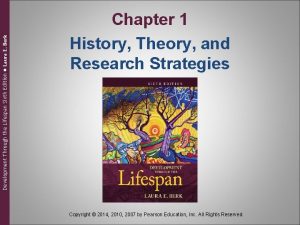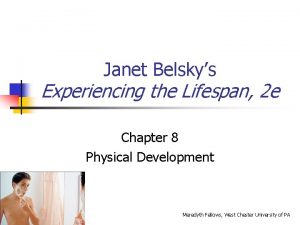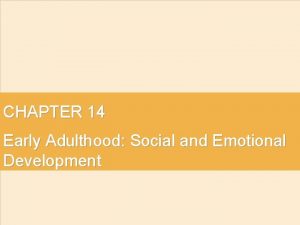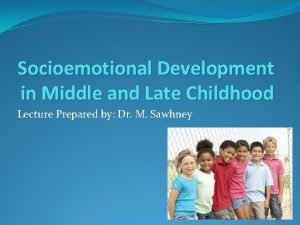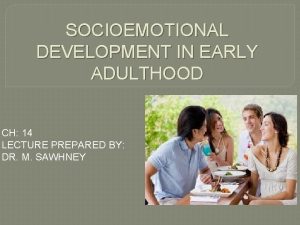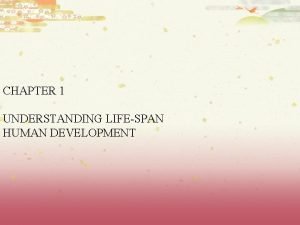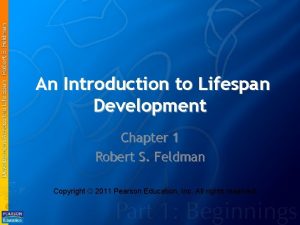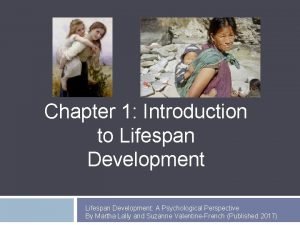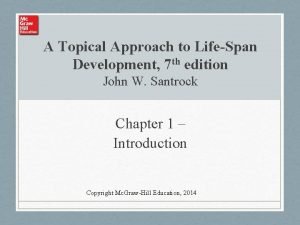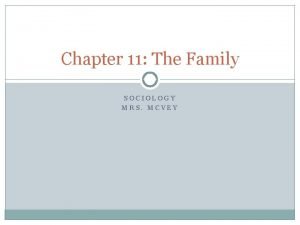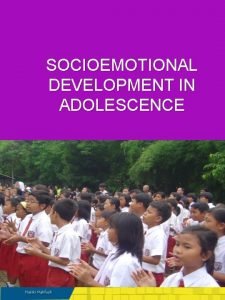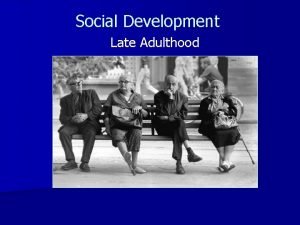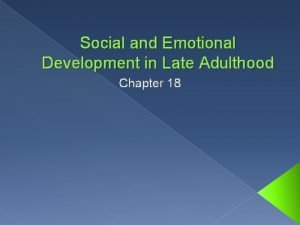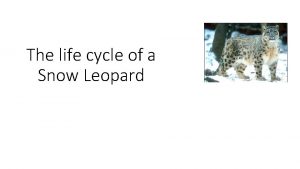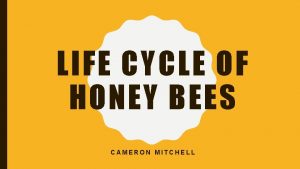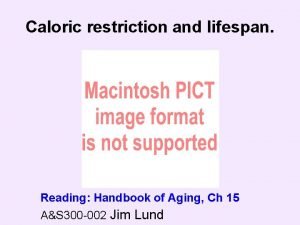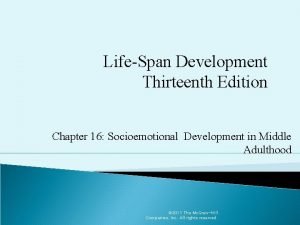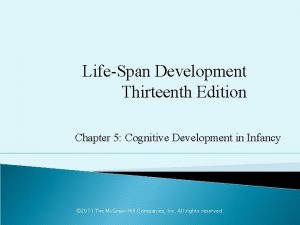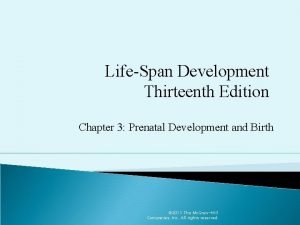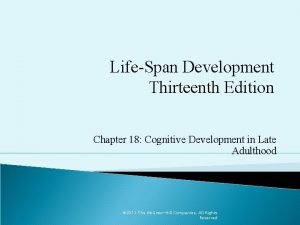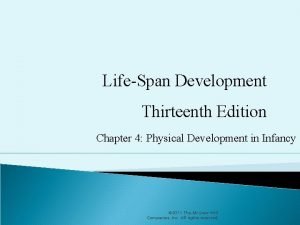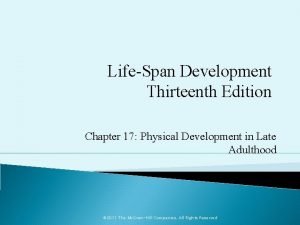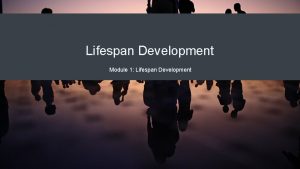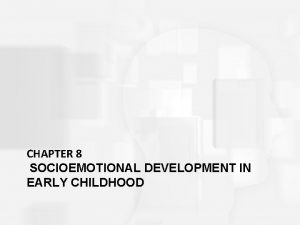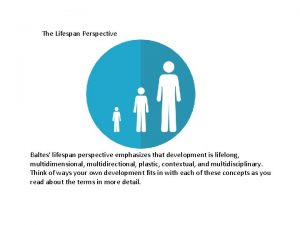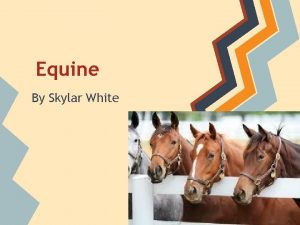LifeSpan Development Thirteenth Edition Chapter 14 Socioemotional Development






























- Slides: 30

Life-Span Development Thirteenth Edition Chapter 14: Socioemotional Development in Early Adulthood © 2011 The Mc. Graw-Hill Companies, Inc. All rights reserved.

Stability and Change From Childhood to Adulthood § Temperament § Researchers have linked several dimensions of childhood temperament with characteristics of adult personality § Easy and difficult temperaments § Inhibition § Ability to control one’s emotions © 2011 The Mc. Graw-Hill Companies, Inc. All rights reserved. 2

Stability and Change From Childhood to Adulthood § Attachment § Romantic partners fulfill some of the same needs for adults as parents do for children § Adults may count on their romantic partners to be a secure base § Securely attached infants were securely attached 20 years later in their adult romantic relationships © 2011 The Mc. Graw-Hill Companies, Inc. All rights reserved. 3

Stability and Change From Childhood to Adulthood § Attachment § Secure Attachment Style § Have a positive view of relationships and find it easy to get close to others § Avoidant Attachment Style § Are hesitant about getting involved in romantic relationships § Anxious Attachment Style § Demand closeness, are less trusting, more emotional, jealous, and possessive © 2011 The Mc. Graw-Hill Companies, Inc. All rights reserved. 4

Attraction, Love, and Close Relationships § Attraction § Familiarity and Similarity § Familiarity is necessary for a close relationship § People seek others who have similar attitudes, values, and lifestyles § Consensual Validation: our own attitudes and values are supported when someone else’s are similar to ours © 2011 The Mc. Graw-Hill Companies, Inc. All rights reserved. 5

Attraction, Love, and Close Relationships § Attraction § Physical Attractiveness § The criteria for beauty can differ § Standards of what is attractive change over time and across cultures § Matching Hypothesis: we choose partners who match our own level of attractiveness © 2011 The Mc. Graw-Hill Companies, Inc. All rights reserved. 6

Attraction, Love, and Close Relationships § The Faces of Love § Intimacy: § Self-disclosure and the sharing of private thoughts § Erikson: Intimacy vs. Isolation § Intimacy is finding oneself while losing oneself in another person § Failure to achieve intimacy results in social isolation § Intimacy and Independence: § Balance between intimacy and commitment, and independence and freedom © 2011 The Mc. Graw-Hill Companies, Inc. All rights reserved. 7

Attraction, Love, and Close Relationships § The Faces of Love § Friendship § Adulthood brings opportunities for new friendships § Gender Differences in Friendships § Women have more friends than men; female friendships involve more self-disclosure and exchange of mutual support § Male relationships are more competitive © 2011 The Mc. Graw-Hill Companies, Inc. All rights reserved. 8

Attraction, Love, and Close Relationships § The Faces of Love § Friendships Between Women and Men § Romantic love: also called passionate love, or eros § Strong components of sexuality and infatuation § Affectionate love: also called companionate love § Based on a deep and caring affection § Consummate love: the strongest form of love © 2011 The Mc. Graw-Hill Companies, Inc. All rights reserved. 9

Attraction, Love, and Close Relationships § The Faces of Love § Sternberg’s Triarchic Theory of Love § Triangle with three main dimensions: § Passion: physical and sexual attraction to another § Intimacy: emotional feelings of warmth, closeness, and sharing § Commitment: cognitive appraisal of the relationship and the intent to maintain the relationship even in the face of problems © 2011 The Mc. Graw-Hill Companies, Inc. All rights reserved. 10

Int en itm im mm acy Co Sternberg’s Triangle of Love 3 types of love combine to form these patterns of love t Present Absent or low Passion Types of Love Infatuation Affectionate Fatuous Consummate Passion Intimacy Commitment © 2011 The Mc. Graw-Hill Companies, Inc. All rights reserved. 11

Attraction, Love, and Close Relationships § Falling Out of Love § Ending a close relationship may be wise if: § You are obsessed with a person who repeatedly betrays your trust § You are involved with someone who is draining you emotionally or financially or both § You are desperately in love with someone who does not return your feelings © 2011 The Mc. Graw-Hill Companies, Inc. All rights reserved. 12

Adult Lifestyles § Single Adults: § Dramatic rise in the last 30 years § Common problems: § Forming intimate relationships with other adults § Confronting loneliness § Finding a place in a society that is marriage-oriented © 2011 The Mc. Graw-Hill Companies, Inc. All rights reserved. 13

Adult Lifestyles § Cohabiting Adults: § Living together in a sexual relationship without being married § Some couples choose to cohabit permanently, rather than get married § Lower marital satisfaction and increased likelihood of divorce © 2011 The Mc. Graw-Hill Companies, Inc. All rights reserved. 14

Adult Lifestyles Insert Figure 14. 4 © 2011 The Mc. Graw-Hill Companies, Inc. All rights reserved. 15

Adult Lifestyles § Married Adults § Marital Trends § Marriage rates in the U. S. have declined in recent years § Average for a first marriage is 27. 5 for men and 25. 6 for women § Marriage in adolescence is more likely to end in divorce © 2011 The Mc. Graw-Hill Companies, Inc. All rights reserved. 16

Adult Lifestyles Insert Figure 14. 5 © 2011 The Mc. Graw-Hill Companies, Inc. All rights reserved. 17

Adult Lifestyles § Married Adults § Cross-Cultural Comparisons § Aspects of marriage vary across cultures § Domesticity is valued in some cultures but not others § Religion plays an important role in marriage in many cultures © 2011 The Mc. Graw-Hill Companies, Inc. All rights reserved. 18

Adult Lifestyles § Married Adults § Benefits of a Good Marriage § Happily married people live longer, healthier lives § Feel less physical and emotional stress © 2011 The Mc. Graw-Hill Companies, Inc. All rights reserved. 19

Adult Lifestyles § Divorced Adults § Divorce has become epidemic in the U. S. § Some groups have a higher incidence of divorce: § § § Youthful marriage Low educational level Low income level Not having a religious affiliation Having divorced parents Having a baby before marriage © 2011 The Mc. Graw-Hill Companies, Inc. All rights reserved. 20

Adult Lifestyles Divorced Adults © 2011 The Mc. Graw-Hill Companies, Inc. All rights reserved. 21

Adult Lifestyles § Remarried Adults: § Most adults remarry within three years after divorce § More unstable than first marriages § Remarried adults have higher rates of depression but improved financial status © 2011 The Mc. Graw-Hill Companies, Inc. All rights reserved. 22

Adult Lifestyles § Gay Male and Lesbian Adults: § Are similar to heterosexual relationships in satisfactions and conflicts § Misconceptions: § Masculine/feminine roles are relatively uncommon § Only a small segment of the gay male population has a large number of sexual partners § Gay male couples have an open relationship while lesbian couples usually do not © 2011 The Mc. Graw-Hill Companies, Inc. All rights reserved. 23

Marriage and the Family § Making Marriage Work § 7 Principles of a Working Marriage § § § § Establishing love maps Nurturing fondness and admiration Turning toward each other instead of away Letting your partner influence you Solving solvable conflicts Overcoming gridlock Creating shared meaning © 2011 The Mc. Graw-Hill Companies, Inc. All rights reserved. 24

Marriage and the Family § Becoming a Parent § Parenting Myths and Reality § Myths: § The birth of a child will save a failing marriage § The child will think, feel, and behave like the parents did in their childhood § Having a child gives the parents a “second chance” at achievement § Parenting is an instinct and requires no training © 2011 The Mc. Graw-Hill Companies, Inc. All rights reserved. 25

Marriage and the Family § Becoming a Parent § Trends in Childbearing § By giving birth to fewer children and reducing the demands of child care, women free up a significant portion of their life spans for other endeavors § Men are apt to invest a greater amount of time in fathering § Parental care is often supplemented by institutional care © 2011 The Mc. Graw-Hill Companies, Inc. All rights reserved. 26

Marriage and the Family § Dealing with Divorce § After a Divorce: § Difficulty in trusting someone else in a romantic relationship § Six Pathways in Exiting Divorce § § § The enhancers The “good enoughs” The seekers The libertines The competent loners The defeated © 2011 The Mc. Graw-Hill Companies, Inc. All rights reserved. 27

Gender, Relationships, and Self. Development § Gender and Communication § Differences in Communication § Two ways of communications (Tannen, 1990) § Women prefer rapport talk: the language of conversation; a way of establishing connections and negotiating relationships § Men prefer report talk: designed to give information, which includes public speaking © 2011 The Mc. Graw-Hill Companies, Inc. All rights reserved. 28

Gender, Relationships, and Self. Development § Women’s Development § Women place high value on relationships and focus on nurturing connections with others § It is important for women to maintain their competency in relationships but to also be self-motivated § Women are more relationship-oriented than men © 2011 The Mc. Graw-Hill Companies, Inc. All rights reserved. 29

Gender, Relationships, and Self. Development § Men’s Development § Pleck’s role-strain view: male roles are contradictory and inconsistent § Men experience stress when they violate men’s roles and when they act in accord with men’s roles § Men experience considerable stress in: § Health § Male-female relationships § Male-male relationships © 2011 The Mc. Graw-Hill Companies, Inc. All rights reserved. 30
 Development through the lifespan 6th edition
Development through the lifespan 6th edition Lifespan development third edition
Lifespan development third edition Lifespan development third edition
Lifespan development third edition Experiencing the lifespan 4th edition
Experiencing the lifespan 4th edition Socioemotional development in infancy
Socioemotional development in infancy Social and emotional development in late adulthood
Social and emotional development in late adulthood Social development early adulthood
Social development early adulthood Socio-emotional development of late childhood
Socio-emotional development of late childhood Early adulthood socioemotional development
Early adulthood socioemotional development Emotional middle adulthood
Emotional middle adulthood Openstax
Openstax Exploring lifespan development chapter 1
Exploring lifespan development chapter 1 Exploring lifespan development chapter 1
Exploring lifespan development chapter 1 Bioecological approach
Bioecological approach Lifespan development a psychological perspective
Lifespan development a psychological perspective A topical approach to lifespan development
A topical approach to lifespan development Ul guidance counselling
Ul guidance counselling Socioemotional maintenance definition
Socioemotional maintenance definition It is a self-portrait composed of many pieces
It is a self-portrait composed of many pieces Late adulthood social development
Late adulthood social development Elders housing preferences reflect a strong desire for
Elders housing preferences reflect a strong desire for Mis chapter 6
Mis chapter 6 Zulily case study
Zulily case study Life cycle of snow
Life cycle of snow Pelikaaniankerias
Pelikaaniankerias Petit four base
Petit four base Splendour beetle
Splendour beetle Life cycle of a honey bee
Life cycle of a honey bee Ponce de leon nationality
Ponce de leon nationality Henry hudson lifespan
Henry hudson lifespan Lifespan of every animal
Lifespan of every animal
